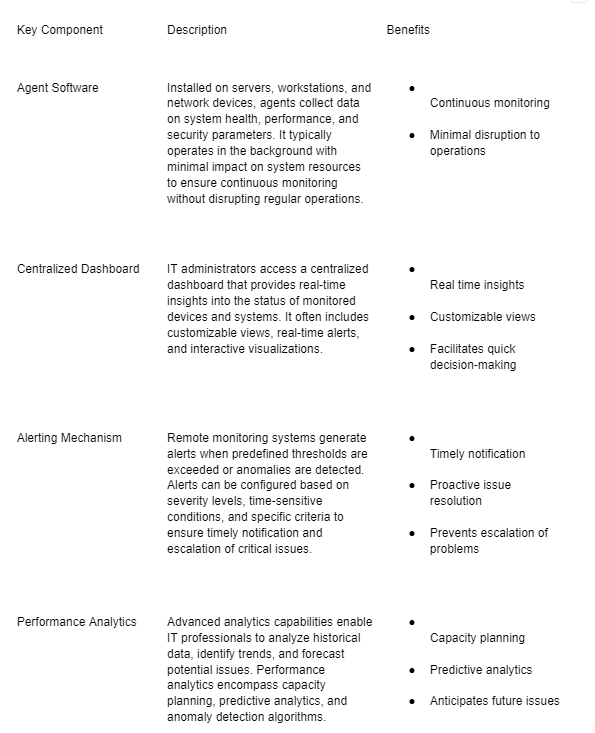Today, businesses heavily rely on their IT infrastructure to sustain operations and remain competitive in a rapidly evolving technological landscape. However, ensuring the smooth functioning of IT systems can be challenging, with issues ranging from minor glitches to major disruptions capable of halting productivity. Traditionally, IT support has operated reactively, addressing problems as they arise. However, with the advancement of remote monitoring technology, proactive IT support has become a game-changer. This article explores how remote monitoring transforms troubleshooting, enabling businesses to prevent downtime, enhance efficiency, and optimize their IT operations.
The Evolution of IT Support
Historically, IT support operated on a break-fix model, where technicians responded to issues only after they occurred. This approach often led to downtime, productivity losses, and increased costs associated with resolving problems. As technology became more complex and critical to business operations, the need for a proactive approach to IT support became evident.
Remote monitoring such as RMM solution emerged as a response to this challenge, allowing IT professionals to monitor networks, servers, applications, and devices in real-time. By continuously collecting data and analyzing performance metrics, remote monitoring systems can identify potential issues before they escalate into significant problems.
Explaining Remote Monitoring
Remote monitoring involves the use of specialized software and tools to track the health and performance of IT infrastructure remotely. These monitoring systems can detect anomalies, trends, and patterns that may indicate underlying issues or vulnerabilities. Key components of remote monitoring include:

The Benefits of Remote Monitoring
- Proactive Issue Resolution
One of the significant advantages of remote monitoring is its capability to identify and address problems before they impact operations. By continuously monitoring IT infrastructure, remote monitoring systems can detect warning signs of potential issues, enabling IT teams to intervene proactively. This proactive approach minimizes downtime, prevents data loss, and maintains productivity.
- Improved Efficiency
Remote monitoring streamlines IT operations by automating routine tasks and providing actionable insights. IT administrators can prioritize tasks based on criticality, allocate resources efficiently, and resolve issues more quickly. Additionally, remote monitoring reduces the need for manual intervention, freeing up IT staff to focus on strategic initiatives rather than firefighting.
- Cost Savings
The proactive nature of remote monitoring translates into cost savings for businesses. By preventing downtime and minimizing the impact of IT issues, organizations can avoid the productivity losses, revenue disruptions, and remediation costs associated with reactive troubleshooting. Furthermore, remote monitoring helps optimize resource utilization, reducing unnecessary expenditures on hardware, software, and support services.
- Enhanced Security
In today’s cybersecurity landscape, protecting sensitive data and infrastructure is paramount. Remote monitoring plays a crucial role in enhancing security by monitoring for suspicious activities, unauthorized access attempts, and potential security breaches. By identifying security threats in real-time, IT teams can implement timely countermeasures to safeguard against cyberattacks and data breaches.
- Scalability
As businesses grow and evolve, their IT infrastructure needs to scale accordingly. Remote monitoring provides scalability by accommodating changes in network size, complexity, and technology requirements. Whether adding new devices, expanding into new locations, or adopting cloud services, remote monitoring adapts to meet the evolving needs of the organization.
Implementing Remote Monitoring
Implementing remote monitoring effectively requires meticulous planning and consideration of several crucial factors. Firstly, organizations must conduct a comprehensive assessment of their existing IT infrastructure to ascertain the scope of monitoring requirements and identify critical assets. Subsequently, careful selection of remote monitoring tools is imperative, ensuring alignment with the organization’s needs, budget, and scalability requirements. Factors such as ease of deployment, integration capabilities, and support services should be carefully evaluated during the tool selection process.
After selecting the tools, configuring and customizing remote monitoring systems is essential to tailor them to the organization’s specific needs. This involves setting up monitoring parameters for key performance indicators (KPIs), defining threshold values, and customizing alerting rules based on business priorities and objectives. Furthermore, providing comprehensive training and skill development opportunities to IT staff is crucial for maximizing the effectiveness of remote monitoring. Equipping staff with the necessary knowledge and skills enables them to utilize remote monitoring tools efficiently, implement proactive troubleshooting practices, and interpret performance metrics accurately.
Real-World Applications
Numerous industries and businesses of all sizes are leveraging remote monitoring to enhance their IT support capabilities:
Healthcare: Hospitals and healthcare providers use remote monitoring to ensure the availability and security of critical medical devices, patient records, and communication systems.
Manufacturing: Manufacturing companies employ remote monitoring to monitor production equipment, track inventory levels, and optimize supply chain operations.
Finance: Financial institutions rely on remote monitoring to safeguard sensitive customer data, detect fraudulent activities, and maintain compliance with regulatory requirements.
Retail: Retailers utilize remote monitoring to manage point-of-sale (POS) systems, track inventory in real-time, and analyze customer behavior for targeted marketing initiatives.
Summary
In today’s digital age, proactive IT support is essential for maintaining the resilience, efficiency, and security of business operations. Remote monitoring technology empowers organizations to transition from reactive troubleshooting to proactive problem prevention. By continuously monitoring IT infrastructure, analyzing performance metrics, and detecting anomalies in real-time, remote monitoring transforms the way IT support is delivered. Businesses that embrace remote monitoring gain a competitive advantage by minimizing downtime, enhancing efficiency, reducing costs, and strengthening security. As technology continues to evolve, remote monitoring will remain a critical component of modern IT operations, driving innovation and enabling businesses to thrive in a dynamic and ever-changing environment.
Published by: Nelly Chavez


















